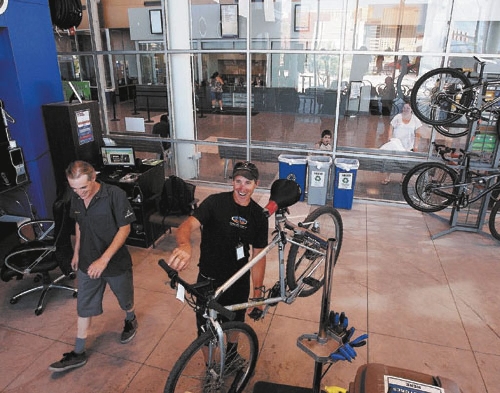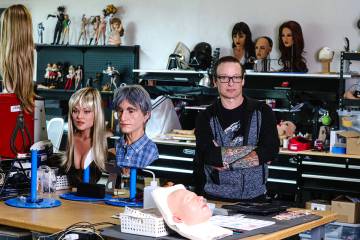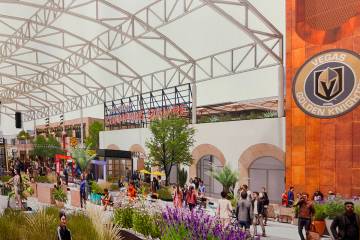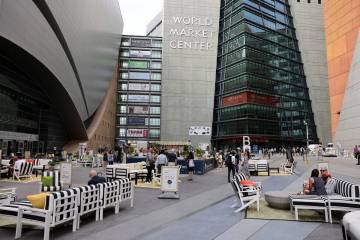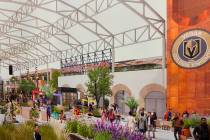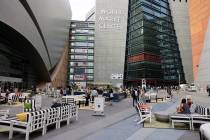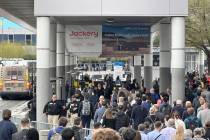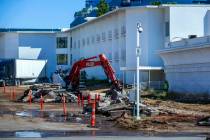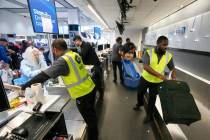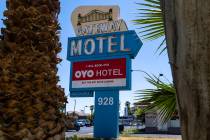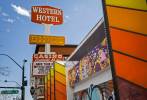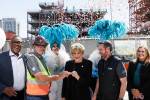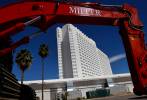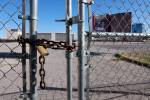New entrepreneurs may boost downtown Las Vegas
Jared Fisher is no politician, developer or casino mogul, but he represents the future of downtown Las Vegas.
Owner of Las Vegas Cyclery on West Charleston Boulevard, Fisher recently opened a second bicycle shop at the new Bonneville Transit Center on Casino Center Boulevard -- right in the heart of downtown.
Fisher's new venture offers secure bike racks, lockers and showers for commuters who take the bus downtown, then bike the rest of the way to work. He's invested about $30,000 so far, mostly on an inventory of bicycles and parts for sale, computer equipment and riding accessories.
The 41-year-old suburbanite said he was willing to take a chance because downtown Las Vegas is slowly changing.
"It's becoming kind of a place to actually go down there and have fun instead of thinking, 'I'm going to get shot,' " Fisher said.
Fisher was the only one to submit a proposal for the Regional Transportation Commission's request for a bicycle shop at the transit center. His one-year contract provides free rent for about 1,200 square feet, and employee wages are subsidized.
Otherwise, Fisher said, he'd be out of business in two days.
"We really haven't made any money," he said. "When I took this on, I knew we wouldn't make any money. That's probably why no other shops bid. I took it on to educate people about cycling and the opportunity to get people to come down here and use their bikes for transportation and not use their cars."
Fisher doesn't have a thriving business yet, but he has plenty of what downtown needs -- faith and willingness to let it ride.
Efforts to revitalize downtown got a boost in December when online retailer Zappos.com announced it will relocate corporate headquarters and as many as 1,200 jobs to Las Vegas City Hall, which will undergo $65 million in renovation.
That's good news for a downtown that not long ago was written off as a downscale district of low-rent motels and activities of a shady nature.
An independent analysis by Restrepo Consulting Group projects that Zappos.com's downtown campus will have an economic impact in excess of $270 million at full build-out.
Is that enough for downtown to turn the corner?
Probably not, but it is an economic shot in the arm.
"The evolution of downtown is not going to happen overnight," said Jeremy Aguero, a native Las Vegan and principal of Applied Analysis, a business advisory firm. "It's going to take a lot of effort from a lot of people, not only from the mayor, but from businesses."
That means more opportunity for small-business pioneers like Fisher willing to take a chance that downtown's decade-long resurgence -- fueled by artists, the gay community and young people in search of low rent and an urban lifestyle -- is about to blossom.
Civic leaders say Zappos.com's presence can only help. It'll draw a younger, more diverse crowd to patronize the restaurants and bars that have sprung up in the Fremont East District, for starters, and they may even decide to live near their new office, helping develop the residential base that is critical to a vibrant urban core.
But while declining real estate values have made downtown more affordable, the transformation from a business and entertainment district to a place to live is at least 10 years away, Aguero said. The reality is that downtown still lacks residential amenities such as a major grocery store, shopping, parks and schools, he said.
Zappos.com spokeswoman Jamie Naughton said she's not really sure how many of the company's 1,000-plus employees will want to live closer to Fourth and Stewart after the old City Hall is renovated for them in early 2012. While the average Zappos.com employee is in his or her mid-30s, many already have established homes elsewhere in the valley and won't mind a new commute route, she said.
"There's going to be a need for a variety of housing options," she said. "I know a handful of our employees already live down there."
Naughton will soon be one of them. In a few weeks she'll move from her southwest Las Vegas Valley house into The Ogden, an upscale high-rise apartment building about a block from the old City Hall.
"I just love the environment, the beat, the walkability of it," she said.
But sometimes love isn't enough.
HITTING BOTTOM -- BUT A COMEBACK SEEN
The market was on fire in 2006 when New York investors David Mitchell and Barnet Lieberman paid $100 million for 14 acres roughly from Main Street to Casino Center and Garces Avenue to Clark Avenue.
The 61-acre Symphony Park was taking shape across from the behemoth World Market Center, part of the "critical mass" that urban planners said was essential to attract new business and residents to the core of the city.
The five-block parcel was originally zoned for a live-work project. Cleveland-based Forest City Enterprises acquired an 80 percent share in the project in 2007 and is developing the new City Hall and the Bonneville Transit Center.
Were it not for those public investments, the New Yorkers would have lost big when the Great Recession crushed Las Vegas real estate. Financing dried up and construction came to a near standstill, leaving many projects touted as downtown game-changers dead in the water.
Property values plummeted. Average price per acre downtown fell to $700,000 in the second quarter of 2010, based on a single 0.6-acre transaction at the northeast corner of Charleston and Casino Center, Applied Analysis reported. It's down from $2.9 million an acre in the first quarter of 2009 and $4.1 million in the first quarter of 2008.
Million-dollar condo developments such as Newport Lofts, Streamline and Juhl went back to the lenders. Others never made it out of the ground.
One of those was Gateway Las Vegas, a high-rise planned at Charleston Boulevard and Fourth Street.
Paul Murad, president of Metroplex Realty, paid $3.2 million for the Gateway site -- and let it go five years later for $1.7 million in a short sale to Stephen Siegel of Siegel Suites.
"I lost money because I bought in 2005 at the height of the market and then the market turned on everyone," said Murad. "Everybody who bought in 2005 and 2006 and early in 2007 lost money."
But now, with downtown prospects looking up and properties that once sold for $150 a foot offered at $30 to $40, Murad said he would get back into the downtown market -- if he had the cash.
"There's definitely interest now for the first time in five years,'' Murad said. "The mood just started changing."
Joe Merica purchased four homes on Seventh Street in what was once a swanky neighborhood for $140,000 to $210,000, starting in 1979. He feels lucky to have sold the property to investors for $3.3 million in 2006.
Three years later those properties -- nearly a full acre -- were auctioned for just $880,000.
"Value went through the roof and as fast as it went up, it came down," said Merica, who now lives at his parents' ranch in Oregon.
Merica said downtown has definitely hit bottom and is ready to come back, though anyone investing now needs cash because it's difficult to get financing.
"It's going to come back and be a big part of Las Vegas in a very cool way,'' Merica said. "Downtown Las Vegas has everything going for it -- the transportation center, the Arts District. It's got a good vibe. It's got quiet streets and mature landscape and old architecture."
Those amenities -- at a reasonable price -- have helped make older, downtown neighborhoods such as Huntridge Park, south of Charleston and east of Maryland Parkway, a popular destination for those seeking the character of older neighborhoods in a city where old is in short supply.
Bonnie Barberini, a broker at Avalon Realty and Oaktree Management, said law firms that want to be near the Regional Justice Center, Clark County courthouse and federal courthouse have driven up prices, but downtown homes can still be had for under $100,000.
A three-bedroom, 1,400-square-foot home at 910 Sage Tree Court sold for $75,000 in April, and a one-bedroom, 968-square-foot home at 214 S. 11th St. sold for $20,000 last year, she said.
Those looking for newer digs downtown can check out the Newport Lofts, a high-rise condo tower at 200 Hoover Ave., where units have sold for as little as $79,000, or the SoHo Lofts on Las Vegas Boulevard, where prices range from $117,000 to $642,000.
PROMISES BUT STILL NO LAND RUSH
But for its reasonable prices and much-hyped promise, downtown has yet to see a land rush. No downtown vacant land transactions have been recorded this year, and few commercial properties have traded hands.
"With limited supply, landowners are perhaps holding out to see what happens with some of the redevelopment projects, including the Plaza (hotel) remodel and Smith Center after it opens for business," said Jake Joyce, project manager for Applied Analysis.
Yet there is commercial activity. Downtown and the surrounding area seem to be where some of the last major active office construction is occurring, Joyce said. Forest City, for example, plans more than 1 million square feet of mixed-use development downtown.
Land transactions have been limited primarily to the south valley, said Bill Lenhart, president of Sunbelt Development and Realty Partners in Las Vegas.
Lenhart readily admits downtown is not for everyone.
"I can't remember the last time I went down there," said Lenhart a 25-year Las Vegas resident. "I'm sure it's because I had visitors who wanted to see it.''
Still, he sees potential.
"I think Zappos is going to make a difference,'' he said. "It's going to bring a younger vibe down there."
Richard Bianco, retired real estate agent from California, owns investment homes on the east side of Las Vegas, but has yet to venture downtown. It's still a little sketchy for families, he said.
"Downtown will someday be a bargain, like in Nashville, where they turned all those old houses into recording studios," Bianco said. "But they've got to go down there and dress that up. You've got to put a rudder on the boat. I think that's where Oscar (Goodman) came in and turned it around."
Goodman, who last week left office after a dozen years as mayor, made downtown a big part of his agenda.
During Goodman's time in office, the Golden Nugget added a $150 million hotel tower and the El Cortez invested $28 million in renovations. One night, Goodman attended three grand openings in the Fremont East District, where the Las Vegas Redevelopment Agency will reimburse business owners up to $95,000 for facade and signage improvement and waive the $20,000 tavern license fee to help jump-start private investment and business creation.
That public investment primes the pump, downtown planners say.
"I remember when property owners on the east side of the railroad tracks saw what we were doing with the Ruvo Center and Smith Center and they had confidence and started putting money in their projects," Goodman said.
Even going out the door, Goodman is selling downtown. The greatest investment value today is the cheap motels along East Fremont from Eighth Street to Eastern Avenue, he said the night before his wife, Carolyn, won the election to take his place.
STILL THE NEED FOR DIVERSITY
Aguero, the Applied Analysis consultant, and many others give much of the credit for getting downtown this far to Goodman. Some of his efforts worked and some flopped, but if you step back and look at the big picture, Goodman left downtown in better shape than he found it, he said.
Eric Louttit, vice president of Forest City Enterprises, said Goodman played an active role in convincing his company to invest in downtown.
Along with developing City Hall, Forest City has a 70-year ground lease for 6.5 acres zoned unrestricted hotel-gaming, in Symphony Park.
"It's getting there, with things like the Performing Arts Center and Lou Ruvo Center," Louttit said of downtown's revival. "Those are things that bring demand with them. That will help drive demand for space downtown.
"Frankly, the thing Las Vegas suffers from is there needs to be a bit more diversity in the economy. Other than government, there's not a lot of office users. With Zappos and the new City Hall, my sense is there is growing demand for space downtown."
But big public works projects can only do so much. Companies and individuals must roll the dice.
Jared Fisher said his risk on the transit center bike shop is now limited, but it won't be that way for long.
Each year he's in business, the RTC rent and wage subsidies drop 10 percent, ending altogether in a decade.
But Fisher believes in the future of downtown, as well as the idea is that people who live in the suburbs will bike to a bus stop, take the bus downtown and leave their bikes at his shop for repair or storage. Membership is $20 a year. It's 3 cents an hour for bike parking.
So far, only one or two people use the facility each day, he said, but he's not worried.
"It serves a good purpose. I'm doing the right thing," Fisher said. "I'm always under the philosophy that if you don't try, you'll never know."
Contact reporter Hubble Smith at hsmith@reviewjournal.com or 702-383-0491.
Downtown business timeline



